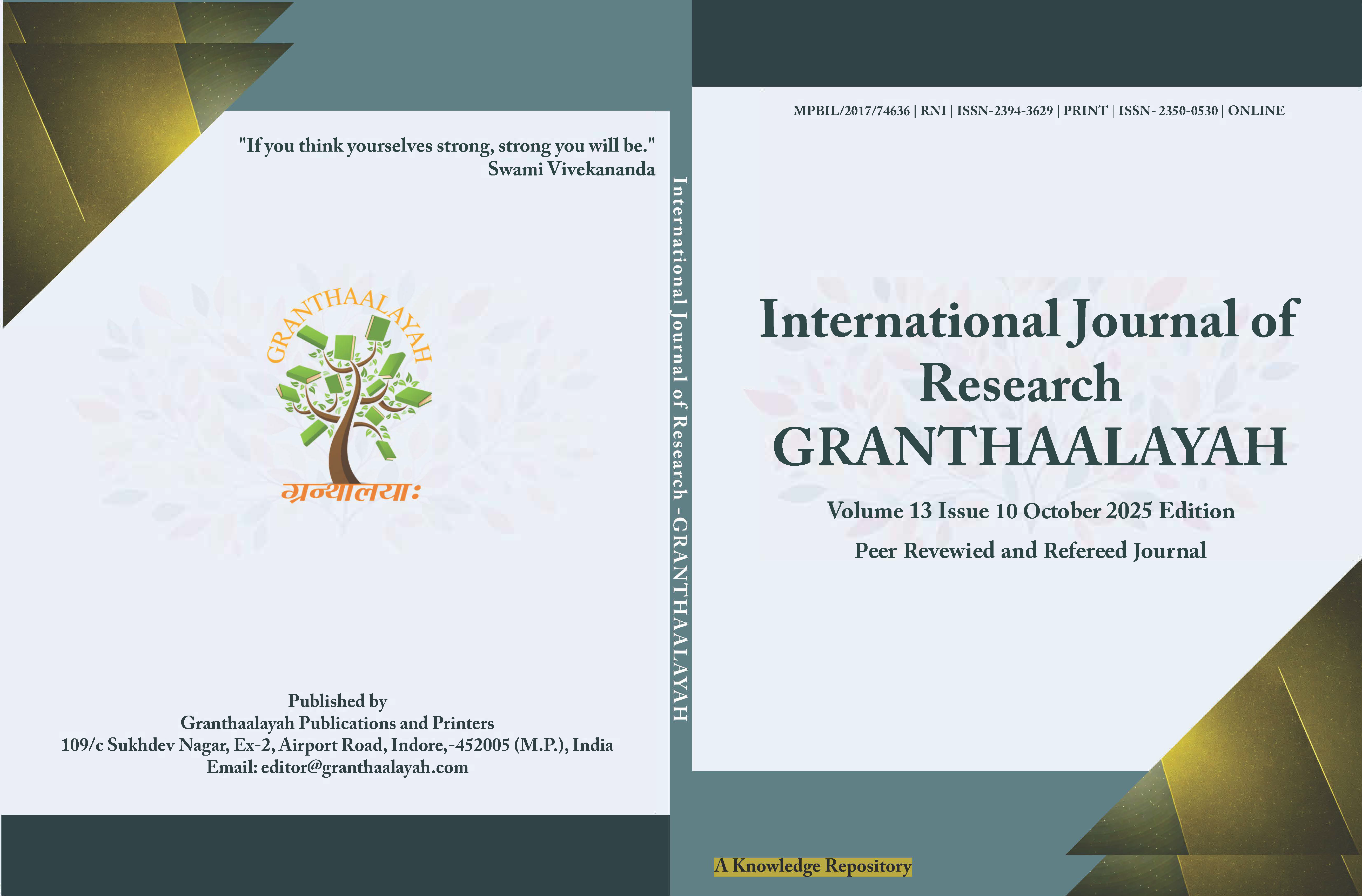UNDERSTANDING MIGRATION PATTERNS OF ANIMALS AND SOCIO-ECOLOGICAL TRANSITIONS IN GARHWAL REGION (UTTARAKHAND) DUE TO CLIMATE CHANGE
DOI:
https://doi.org/10.29121/granthaalayah.v13.i10.2025.6449Keywords:
Climate Change, Animal Migration, Livestock, Anthropocentric Development, HimalayasAbstract [English]
The Garhwal region of Uttarakhand, situated in the central Himalayas, stands as one of India’s most ecologically diverse and environmentally sensitive zones. Encompassing a vast altitudinal range, from subtropical valleys to alpine meadows and glaciated peaks, it harbors a unique assemblage of flora and fauna that have evolved intricate adaptations to the region’s climatic variability. The lives of both wild and domesticated animals in this mountainous landscape are deeply intertwined with seasonal rhythms, resource availability, and altitudinal migration patterns that have persisted for centuries. These migratory cycles, whether of pastoral herds moving to the “bugyals” or of wildlife following the gradient of vegetation and temperature, constitute the ecological backbone of Garhwal’s mountain systems. Here, we shall delve into the intricacies and understandings of changing/transitioning migratory patterns of animals in the concerned region, driven mainly by climate change. We shall also (briefly) allude towards the impacts laid upon socio-economic and cultural variables, in an effort to understand the parallel connections between climate change, anthropocentric dynamics and animal/livestock patterns.
Downloads
References
Chandra, N., Singh, G., Rai, I. D., Mishra, A. P., Kazmi, M. Y., Pandey, A., Jalal, J. S., Costache, R., Almohamad, H., Al-Mutiry, M., et al. (2023). Predicting Distribution and Range Dynamics of three Threatened Cypripedium Species Under Climate Change Scenario in Western Himalaya. Forests, 14(3), Article 633. https://doi.org/10.3390/f14030633 DOI: https://doi.org/10.3390/f14030633
Down to Earth. (2024). Himalayan Wildlife Crisis: Musk Deer and Pheasants Face Altitude Squeeze.
Ilyas, O. (2023). Tree Regeneration and Vegetation Structure in High Altitudes of Uttarakhand Himalaya, India. International Journal of Ecology and Environmental Sciences, 47(2). https://doi.org/10.55863/ijees.2022.0119 DOI: https://doi.org/10.55863/ijees.2022.0119
Jethi, R., et al. (2025). Toward Climate Change and Community-Based Adaptation/Mitigation Strategies in Hill Agriculture. Indian Council of Agricultural Research (ICAR) Repository. [Preprint/Technical article]
Lochan, R., Sharma, D. K., and Kumar, A. (2024). Habitat Suitability and Projecting Distribution Shifts of Himalayan MOnal (Lophophorus Impejanus) Habitats Across Changing Landscapes of the Indian Himalayan Region. Scientific Reports, 15, Article 25622. https://doi.org/10.1038/s41598-025-11729-w DOI: https://doi.org/10.1038/s41598-025-11729-w
MDPI. (2023). Vegetation Characteristics Based Climate Change Vulnerability Assessment of Temperate Forests of Western Himalaya. Forests, 13(6). https://doi.org/10.3390/f13060848
Pandey, R., Sharma, J., Singh, R., Rawat, M., Saklani, H., Tomar, P. K., Tiwari, L., Bhatt, I. D., Chand, T., Bala, N., et al. (2025). Vegetation Characteristics Based Climate Change Vulnerability Assessment of Temperate Forests of Western Himalaya. Forests, 13(6), Article 848. https://doi.org/10.3390/f13060848 DOI: https://doi.org/10.3390/f13060848
PubMed/NLM. (2025). Assessment of Climate Change Pattern in the Pauri Garhwal of the Western Himalayan Region: Based on Climate Parameters and Perceptions of Forest-Dependent Communities. PMID: 32902796.
PubMed/National Library of Medicine. (2024). Insect Pest Scenario in Uttarakhand Himalayas, India, Under changing Climatic Conditions. PMID: 35445862.
Rautela, P., and Karki, B. (2024). Impact of Climate Change on Life and Livelihood of Indigenous People of Higher Himalaya in Uttarakhand, India. American Journal of Environmental Protection, 3(4), 112–124. https://doi.org/10.12691/env-3-4-2
Rawat, D., and Schickhoff, U. (2025). Changing Climate Scenario in High Altitude Regions: Comparison of Observed Trends and Perceptions of Agro-Pastoralists in Darma Valley, Uttarakhand, India. In Mountain landscapes in transition: Effects of land use and climate change (429–447). https://doi.org/10.1007/978-3-030-70238-0_18 DOI: https://doi.org/10.1007/978-3-030-70238-0_18
Rawat, G. S., and Schickhoff, U. (2023). Climate Change and the Himalaya: The Physical Basis and Ecosystem Impacts. Springer.
Saino, N., et al. (2024). Climate Change Effects on Migration Phenology of Birds: A Review. Ecology Letters, 14(7), 707–719.
Sati, V. P. (2025). Livestock Farming in the Uttarakhand Himalaya, India: Use Pattern and Potentiality. Current Science, 111(12), 2023–2024. https://doi.org/10.18520/cs/v111/i12/1955-1960 DOI: https://doi.org/10.18520/cs/v111/i12/1955-1960
Singh, R., et al. (2025). Wildlife Diversity Along the Altitudinal Gradients in the Garhwal Himalaya. Asian Journal of Conservation Biology, 10(1), 99–114.
The New Indian Express. (2023, November 20). Climate Change Alters Avian Migration Patterns in Uttarakhand.
Tiwari, P. C., and Joshi, B. (2023). Environmental Changes and their Impact on Migration Patterns in the Central Himalaya. Mountain Research and Development, 35(4), 367–376.
Tuteja, U. (2023). Agriculture Profile of Uttarakhand (1–12). Agricultural Economics Research Centre, University of Delhi.
Upadhyay, H., Vinke, K., Bhardwaj, S., Becker, M., Irfan, M., George, N. B., Biella, R., Arumugam, P., Murki, S. K., Paoletti, E., et al. (2024). Locked Houses, Fallow Lands: Climate Change and Migration in the Himalayan State of Uttarakhand, India. Potsdam Institute for Climate Impact Research (PIK) and The Energy and Resources Institute (TERI).
Xu, J., et al. (2025). The Melting Himalayas: Cascading Effects of Climate Change on Water, Biodiversity, and Livelihoods. Conservation Biology, 23(3), 520–530. https://doi.org/10.1111/j.1523-1739.2009.01237.x DOI: https://doi.org/10.1111/j.1523-1739.2009.01237.x
Creative Commons Licence This work is licensed under a: Creative Commons Attribution 4.0 International License
Published
How to Cite
Issue
Section
License
Copyright (c) 2025 Dr. Sandeep Kumar

This work is licensed under a Creative Commons Attribution 4.0 International License.
With the licence CC-BY, authors retain the copyright, allowing anyone to download, reuse, re-print, modify, distribute, and/or copy their contribution. The work must be properly attributed to its author.
It is not necessary to ask for further permission from the author or journal board.
This journal provides immediate open access to its content on the principle that making research freely available to the public supports a greater global exchange of knowledge.

























